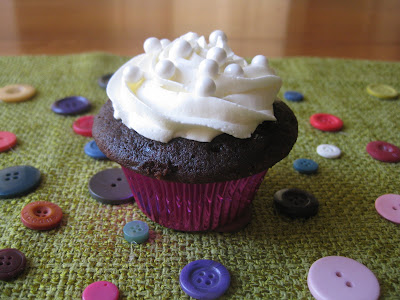
Walking into a See's Candy store never fails to make me sentimental. My parents would always include one of those kids Holiday boxes in our Christmas stockings and anytime we went to our local shopping mall, the big treat was to go on the carousel and pick out 6 sugar sticks or a sucker from See's. My two favorite chocolates from See's have been and will forever be: the Mocha (probably an early warning sign of my impending addiction to coffee) and the Scotchmallow.
A Mocha inspired cupcake promises to be a future adventure on Pixie Crust, but today, I'll share the Scotchmallow inspired cupcake I created. This cupcake has a good balance of having the flavors of a Scotchmallow candy, without being overly sweet. I will recommend, however, that you make sure you fill each cupcake with enough caramel and include enough marshmallow fluff to taste marshmallow-y enough (excuse the technical language ;) ). The actual chocolate cake recipe is AWESOME. Funny enough, I had yet to have discovered the perfect chocolate cake recipe: one that is light and fluffy, but also moist and rich enough. I actually stumbled upon this fantastic recipe on the back of the Swans Down cake flour box. I altered it slightly, but the base recipe is truly close to perfectly formulated, in my opinion.
If you decide to make these cupcakes, one tip I would offer is to make the caramel sauce the night before to cut out one less thing to do the day you bake, assemble, and frost the cupcakes.

Chocolate Cake Recipe
Yields 24 cupcakes
Ingredients:
2 1/4 cups sifted cake flour (I used Swans Down)
2 tsp baking soda
1 1/4 cup granulated white sugar
1 cup brown sugar
1 stick butter, at room temperature
1 tbsp vanilla extract
3 large eggs
1 cup sour cream
4 oz unsweetened baking chocolate
1 cup boiling water
Sift the flour and set aside. Whip the butter in an electric mixer fitted with paddle attachment until creamy. Add the granulated sugar to the butter and mix until creamed. Add the brown sugar and continue to mix on medium/high for an additional 2 minutes.
Add the eggs and vanilla extract and mix until well combined. Add the melted baking chocolate. Mix in the baking soda last.
Add the flour in batches, alternating with adding sour cream. Mix on medium until well combined- do not over mix!
Lastly, remove the bowl from the mixer stand. Add in the boiling water and hand stir until combined.
Bake for 25-35 minutes, until cake springs back to the touch and/or an inserted toothpick comes out clean.
Homemade Caramel Sauce (caramel recipe courtesy of Giver's Log)
Tools/Equipment:
3-4 quart saucepan
candy thermometer
Ingredients:
1 cup unsalted butter (2 sticks)
2 1/4 cups brown sugar
1 cup light corn syrup
1 14-oz can sweetened condensed milk
1 tsp vanilla extract
Cut butter into evenly sized cubes and melt over low heat in large 3-4 quart saucepan.
Once butter is fully melted, add brown sugar, being careful to avoid the sides of the pan. If any stray sugar crystals fall onto side of pan, carefully brush off with a wet pastry brush.
Once butter and sugar are fully combined, add corn syrup and condensed milk. Clip on candy thermometer to side of pan.
Cook mixture on low heat (still continually stirring) for about a minute or two. Increase heat to medium and continue to cook/ stir until mixture reaches 225 degrees. Once the mixture is removed from heat, stir in vanilla extract.
NOTE: Giver's Log gave 230 as the temperature to remove caramel from heat for it to form a sauce consistency, however, my sauce was still too hard when cooked to 228 (my oven and stove get crazy hot {so hot, my oven melted my adorable Anthro kitchen timer}, so I'd chock it up to different appliances and varying candy thermometers). If your sauce turns out too hard (once it's completely cooled and consistency is determined) gently reheat the caramel and add a couple table spoons of cream and water, stirring until fully combined. The mixture should be slightly more runny than desired when warm because it will continue to thicken once it's fully cooled.
Marshmallow Swiss Meringue Frosting
Ingredients: (Swiss meringue base courtesy of Martha Stewart Online)
4 egg whites
1 cup sugar
3 sticks butter
1 tsp vanilla
2 jars marshmallow cream
Cook egg whites sugar in metal bowl placed inside (not touching) a pot of boiling water. Continually whisk mixture over heat until it reaches 180 degrees. Pour hot egg mixture into mixing bowl fitted with whisk attachment. Whisk until soft peaks form, then add butter in a piece at a time, whisking well after each addition. Once well combined, switch to paddle attachment and mix for 2 minutes.
Add vanilla and marshmallow cream (add as much as desired to taste- I added 1 whole jar) and mix for another minute or two.
Cupcake assembly instructions:
Once cupcakes have fully cooled (you may even want to put them in the fridge for 1/2 hour or so to make the cutting easier), use small paring knife to create a 3/4 inch circular hole in each cupcake. Do not cut all the way through the bottom of the cake.
Using a pastry bag and medium round tip, fill each hole with the caramel mixture and replace cake in hole. (you could skip this part if easier, since no one will see the caramel hole once the cupcakes are frosted).
After the cupcakes are all filled, use a pastry bag fitted with a large star attachment to pipe on frosting.
Decorate as desired. I chose to use some adorable pearl sprinkles I recently bought from Bake it Pretty, but if I had more time, I would have piped more caramel mixture onto the frosting, as well as some chocolate ganache or chips!







